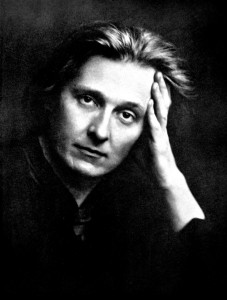
Edward Gordon Craig was born in Stevenage/Hertford in 1872 as son of the actress Ellen Terry and the architect, stage designer and theatre director Edward William Godwin. Between 1889 and 1897 he worked as an actor at Henry Irving’s “Lyceum Theatre” in London and began to design his own figurines and stage designs. Craig propounded an art of the theatre in which reality, instead of being reproduced by traditional representational methods, would be transcended and interpreted by symbol. To him outlines, forms, colours, and lighting were a means of conveying atmosphere. His most original theatrical concept was that the entire “scene” in a dramatic work should be movable in all parts. Craig’s stage productions and, even more, his writings and his highly stylized stage designs, woodcuts, and etchings strongly influenced the anti-naturalist trends of the modern theatre in the first half of the 20th century, though, like his counterpart, Adolphe Appia, he designed very little that was actually staged.
Summary
The subject matter of theatre
- Poetic drama
- Music / pageant and processional drama
- Shakespearian theatre
- Dance
The political purpose or message or dramatic intention
- A-political
- Non-realist drama
- Emphasis on the symbolic
The Actor-Audience relationship
- The actor as an embodiment of qualities / archetypes
- The actor isolated in a spotlight
- The actor as part of the total mise-en-scène
- Strictly fourth wall / presentational
- The movement of the actor
The staging form adopted
- Architectural (the Greek and Roman stage)
- The stage as three-dimensional space
- The stage floor as integral to the design
- Abstract modernism. The use of steps to suggest mise-en-scène
- Suggestive of time and place (anti-realism)
- Kinetic
Directorial interpretation / production style
- The director as overall co-ordinator
- Emphasis placed on coherence
- Unwillingness to compromise
- Non-text based scenarios
- Fast moving, colourful spectacle
Design elements
- Design and planning led to an overall concept
- Mood/atmosphere was created through synthesis
- Exciting symbolic statements
- Changes in scale
- The actor dwarfed in his environment
- Elemental
Role of actors and performance style
- The actor as ‘Ubermarionette’
- The actor as passionless interpreter. The masked actor
- The actor as dancer. The introduction of choreography
- Broad expressive movement
- Close attention to the speaking of the text
- The actor as pliable and responsive
Technical elements
- The proscenium arch as an adjustable frame
- Units that move during the action
- Theatre as a technological machine
- Fully controllable lighting which would mould form
- The abolition of footlights
Audience response
- Kept at a distance to admire the changing spectacle
(p221-22, Mackey, Sally, and Simon Cooper. Drama and Theatre Studies: For Use with All Drama & Theatre Studies A & AS Specifications. Rev. ed. Cheltenham: Stanley Thornes, 2000)
Website: http://www.edwardgordoncraig.co.uk/
Textual sources: